This Italian braided Easter bread with eggs is made with sweet brioche dough nestled with colorful eggs and bright candy sprinkles for a festive Easter treat!
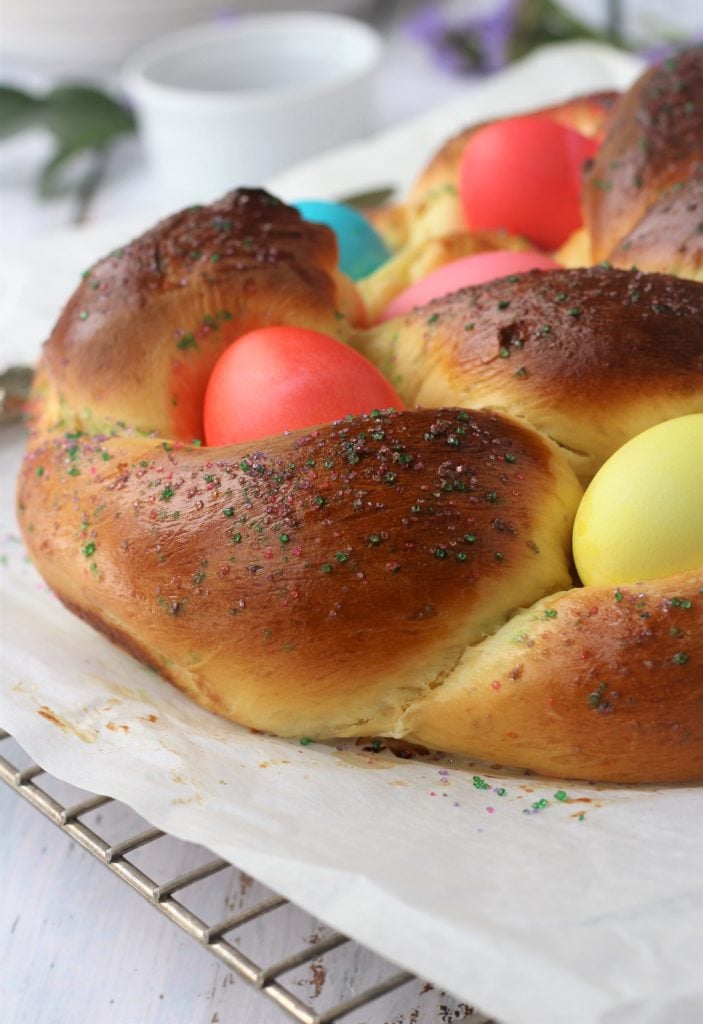
There is no shortage of colorful and festive braided Easter treats with eggs that can be made with different types of dough.
There are cookies that are great for dunking; my mom's savory cuddura cu l'ova that's perfect for enjoying with the baked eggs and then this sweet brioche dough braided and shaped into a crown.
This Italian Easter bread called pane di Pasqua in Italy, or cuddura in Sicilian referring to the circular shape of the bread, is made with soft and fluffy sweet brioche dough flavored with orange zest and vanilla.
If you have not yet tried it, my Sicilian brioche dough recipe is so incredibly versatile. It can be transformed into sugar doughnuts, bomboloni doughnuts filled with a sweet pistachio cream or even cinnamon rolls!
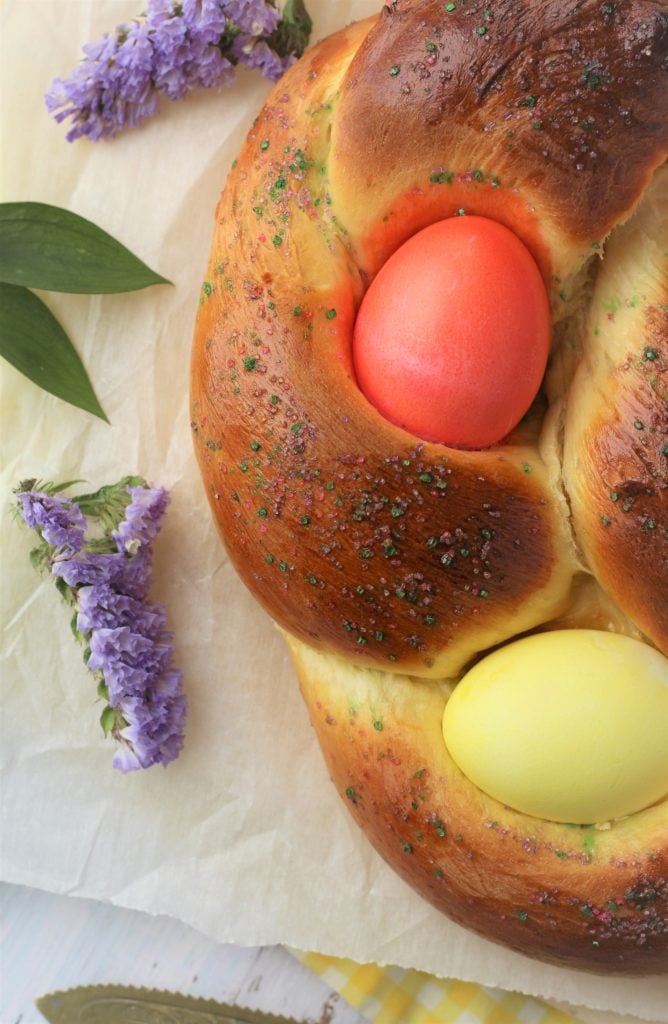
Origins of this bread
There is much symbolism behind the shape of this traditional Italian Easter bread.
The three ropes of dough represent the Holy Trinity; the circular shape refers to the thorny crown worn by Jesus on the cross, and the eggs symbolize rebirth.
The colorful eggs and sprinkles are not traditional but a modern addition for a more festive looking bread.
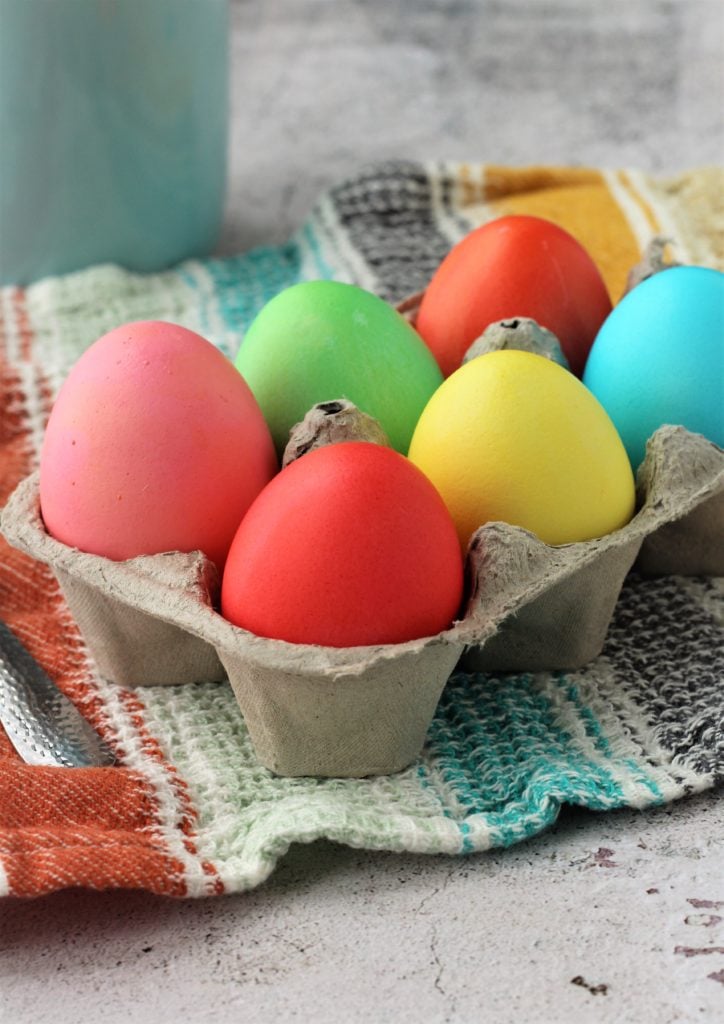
How to dye eggs
Although it is not necessary to dye the eggs, they certainly are much prettier in this sweet Easter bread! I followed the easy instructions found here to dye my eggs using boiled water, vinegar and food coloring.
Here are a few tips for best results:
- Use white eggs for more vibrant color. Brown eggs may be used but will result in muted colors.
- I placed my dyed eggs in an egg carton to dry.
- Allow the eggs to dry completely before nestling them in your bread in order to prevent the color from bleeding into your bread.
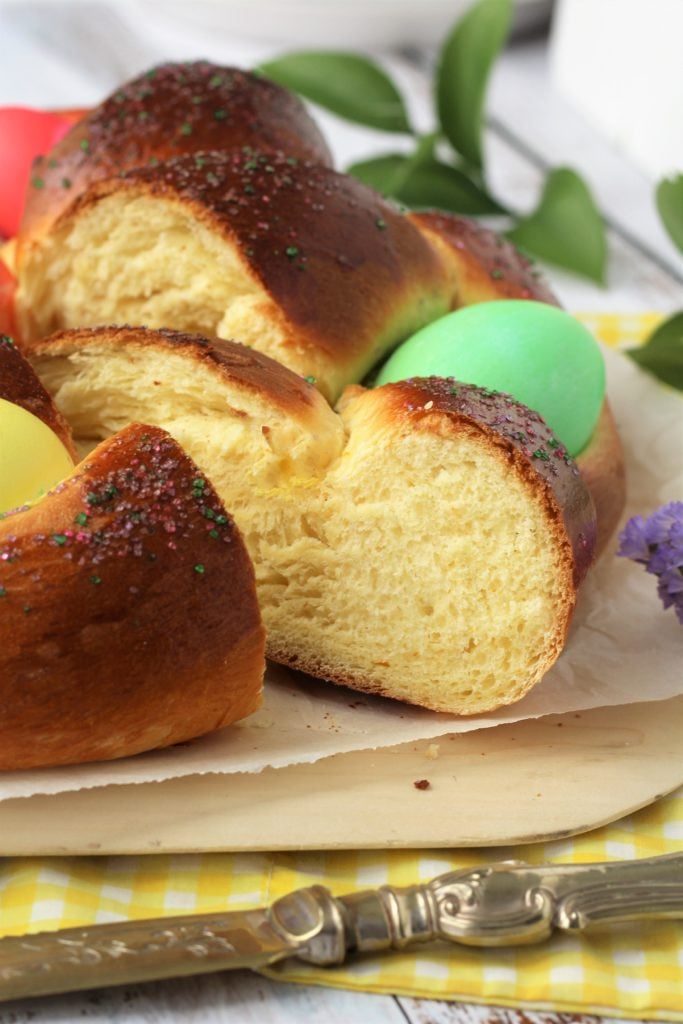
The following are step by step instructions with images to guide you through this recipe. Please scroll to the end of this post for the detailed printable recipe card.
Step by Step Instructions
To make the brioche dough
- Proof the yeast: place a packet of active dry yeast (8 grams) and 1 teaspoon sugar in a bowl. Warm milk until lukewarm and pour over the yeast. Let sit for 10 minutes until foamy.
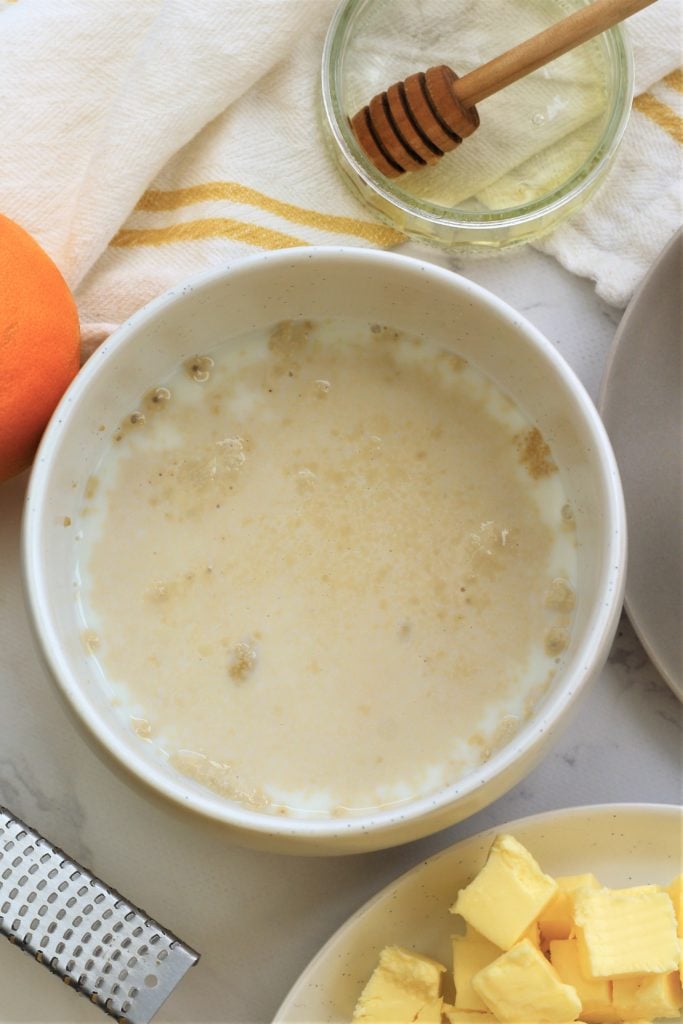
- Meanwhile, in the bowl of your stand mixer fitted with the paddle attachment, mix eggs and sugar until smooth.
- Add honey, vanilla extract and freshly grated zest of 1 orange. Mix well and pour in the yeast mixture.
- Then add cubed softened butter. Mix all ingredients. Note that the butter will not dissolve into the mixture at this point. This is normal.
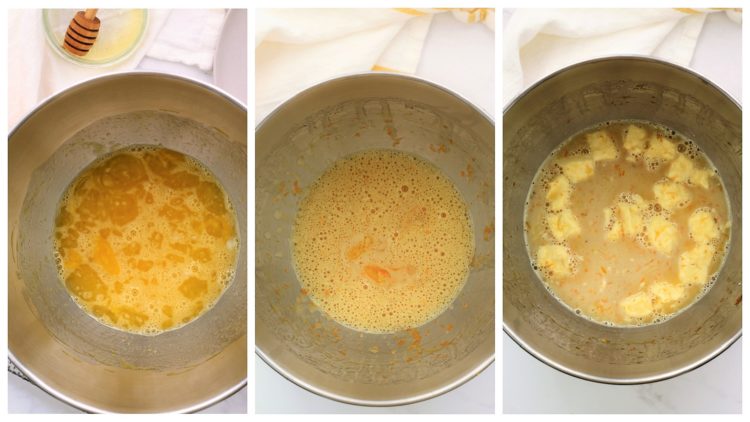
- Remove the paddle attachment and replace with a dough hook.
- With the mixer running on low speed, begin adding flour ½ cup at a time as well as the salt. When all the flour has been added, increase to the next speed and knead the dough for 10 minutes. It will be slightly sticky and will wrap itself around the hook.
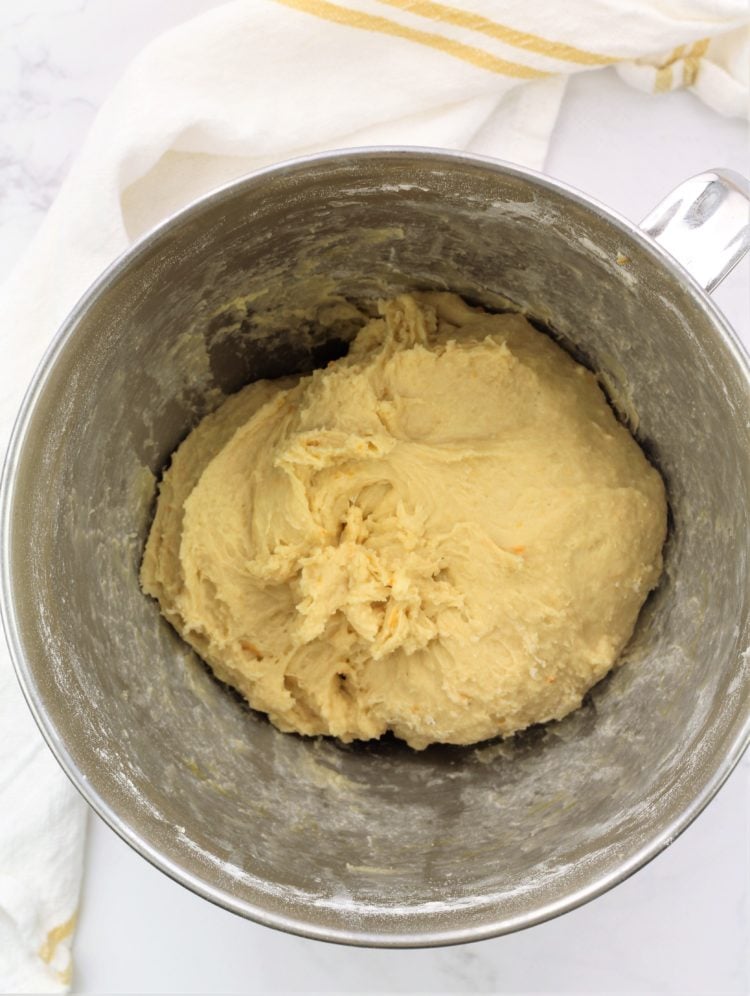
- Transfer the dough into a lightly greased bowl, or you may leave it in the food processor bowl to rise.
- Cover and let rise in warm place for 3 hours until doubled in bulk. I place my dough in my unlit oven with the light on.
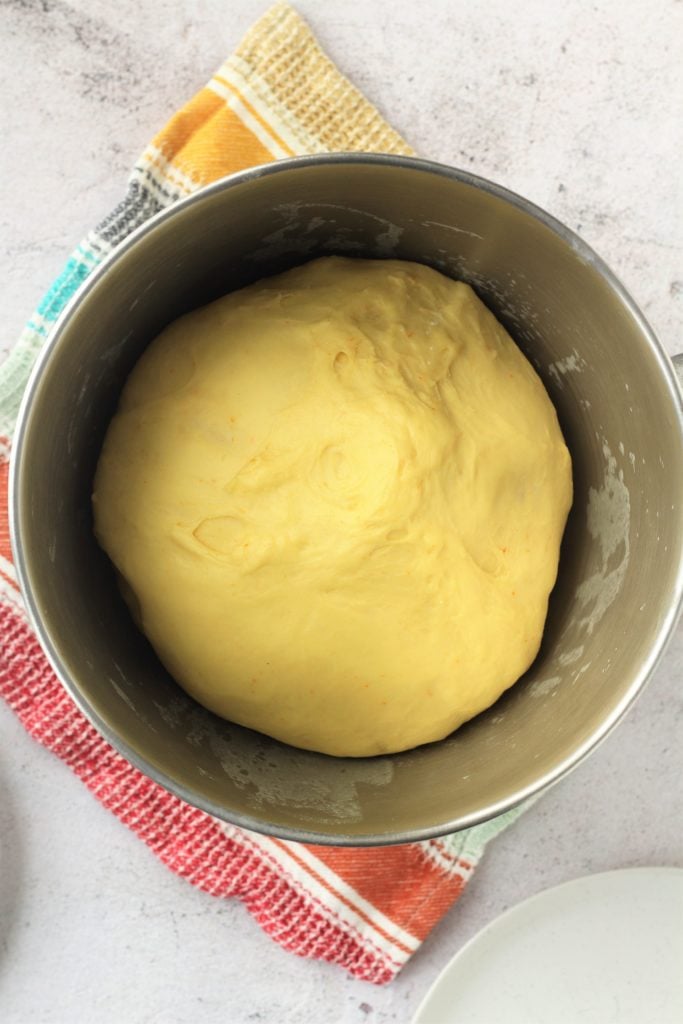
To shape
- After the initial 3 hour rise, use a kitchen scale to divide the dough into 3 equal pieces. Roll out each piece of dough into an approximate 24-inch long rope.
- Place the palms of your hands in the center of the rope and roll gently pushing outwards to stretch out the dough.
- Do not add any additional flour to your surface when rolling the dough. If the dough slides underneath your hands, wet them with just a few drops of water.
- Pinch the ends of the 3 ropes together. Braid the ropes and pinch the other end together. Connect both ends to form a circle, or if you prefer, leave as is.
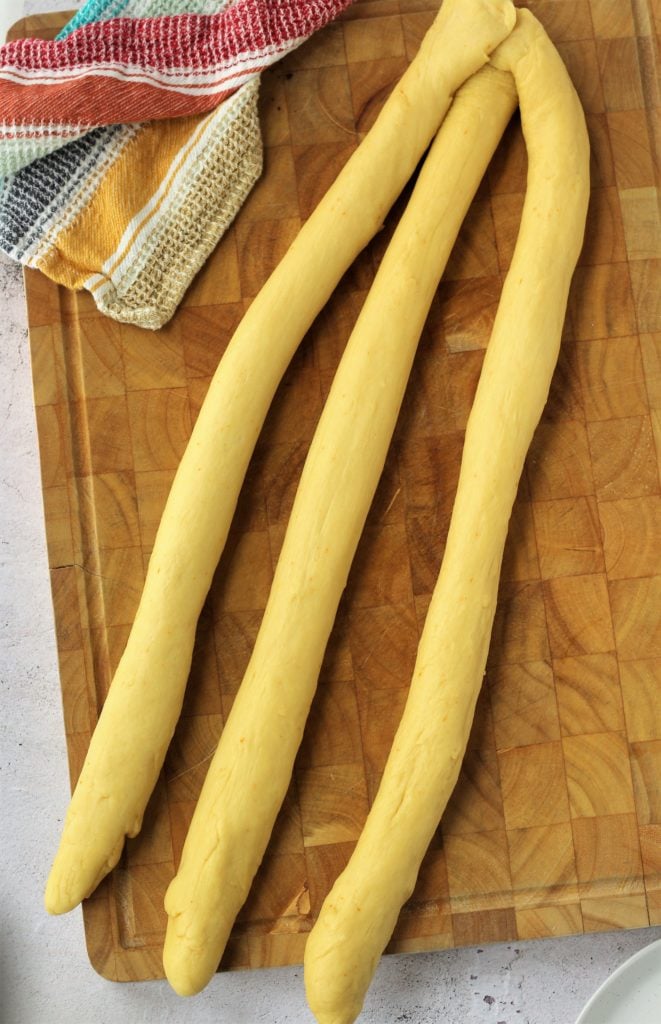
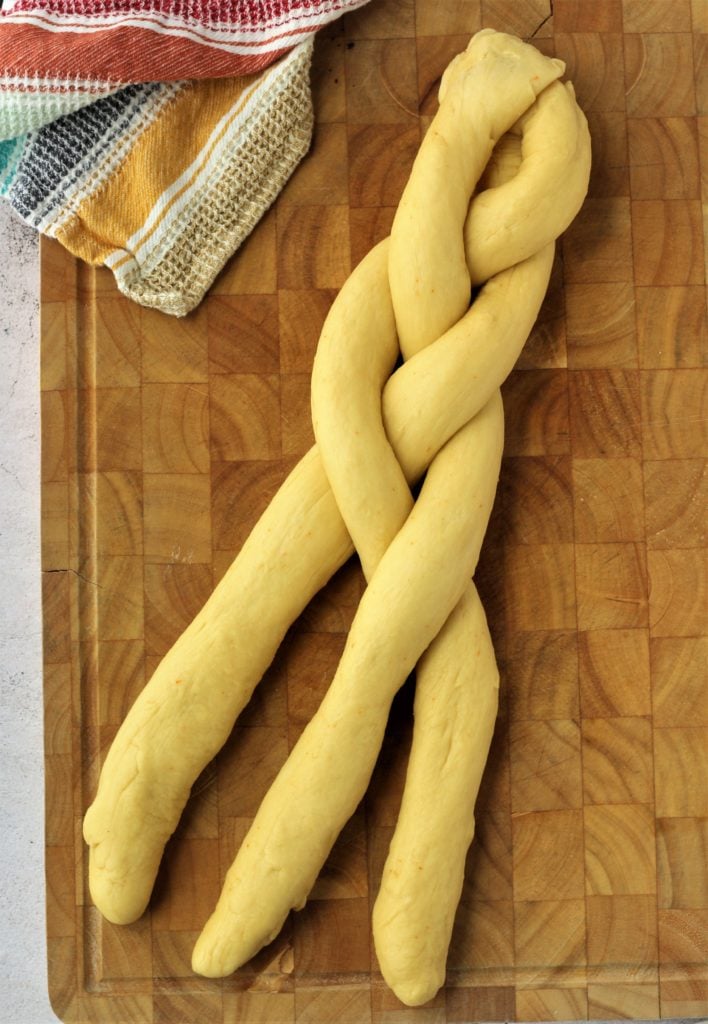
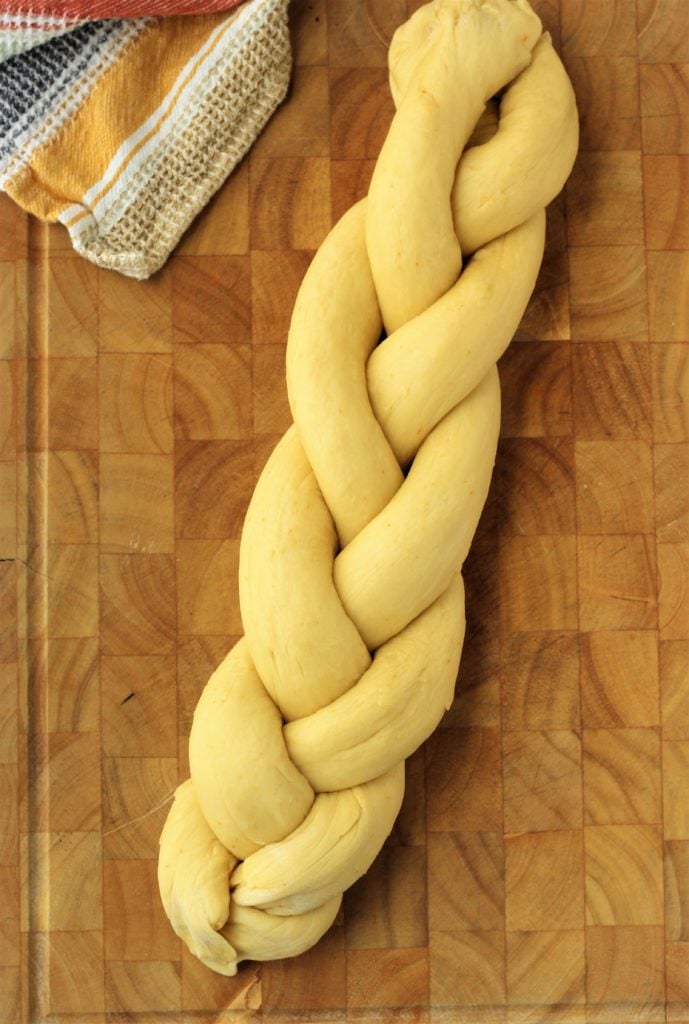
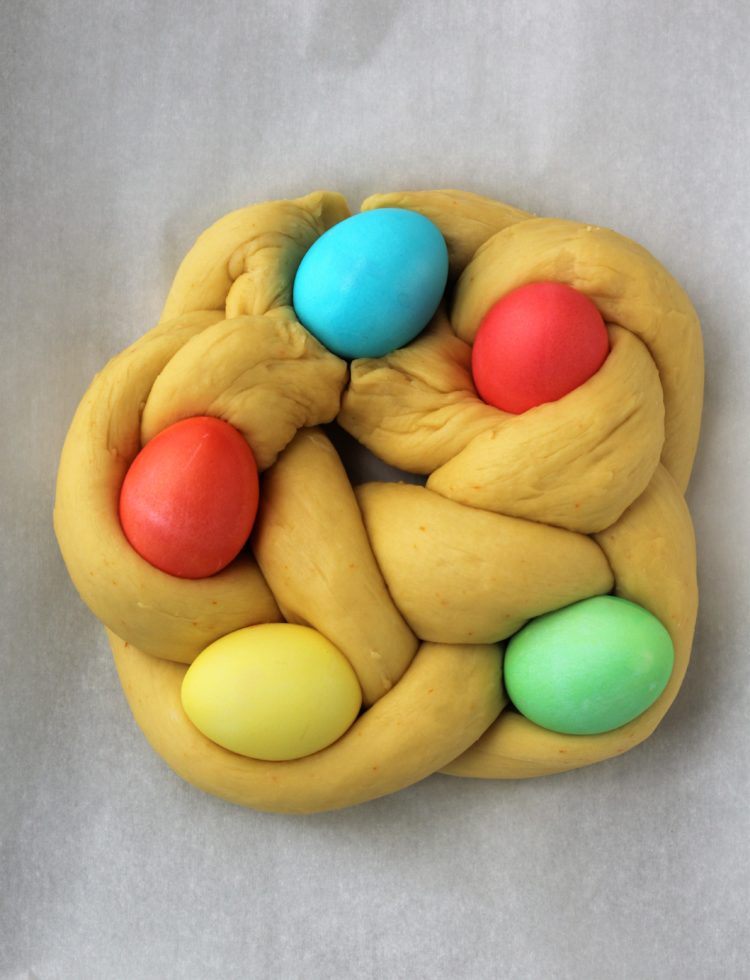
- Nestle the eggs in the bread. Let rise for 2 hours in a warm place.
- Preheat oven to 350 degrees F. Brush the bread with an egg beaten with a spoonful of milk. Sprinkle with colored sprinkles (optional),
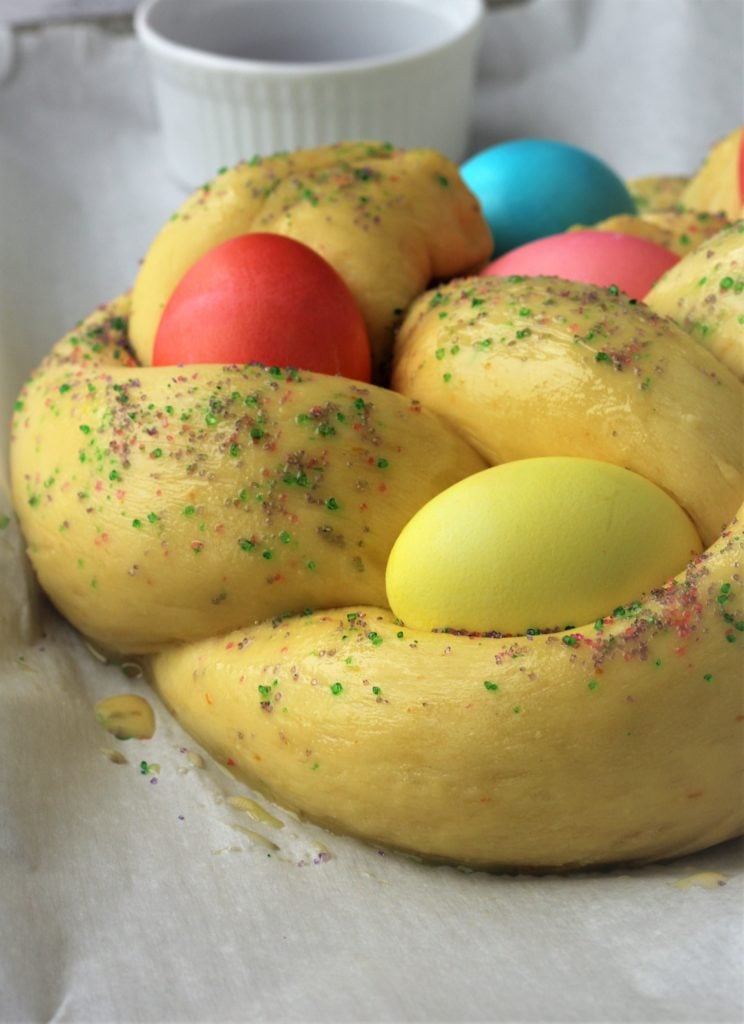
- Bake for 15 minutes, then cover loosely with foil and continue baking for 20-25 minutes until browned both on top and underneath the bread.
- After the initial 15 minutes of baking, you'll notice that the top will already be quite browned however the interior will still be undercooked. To ensure the bread does not burn on the exterior and is sufficiently baked on the inside, do not skip covering the top with a sheet of foil.
- Transfer to a wire rack to cool for a few minutes before serving.
You'll notice I decided to add a sixth egg in the center!
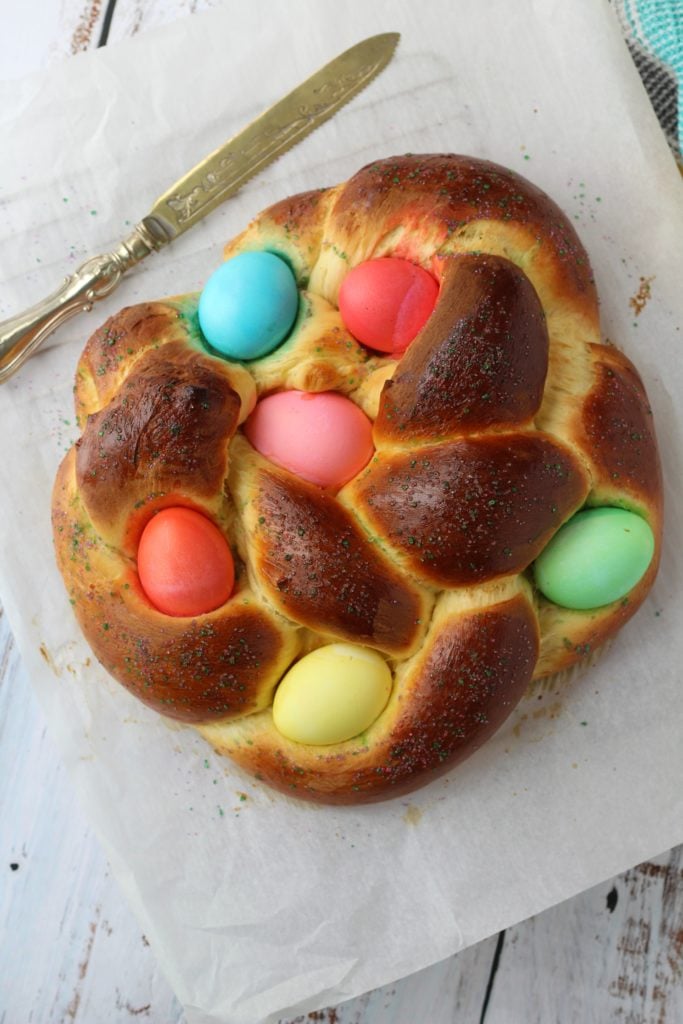
Recipe Notes
-The orange zest may be replaced with lemon zest.
-Replace the vanilla extract with anice extract.
-Add a handful or raisins or chocolate chips to the dough.
-The dough may be prepared the night before and be refrigerated until the following day.
-Let the dough come to room temperature before shaping it.
-For small individual breads, divide the dough into 6 pieces. Roll each piece into a 12-inch rope. Join both ends and twirl the rope (instead of braiding it).
-Place an egg in the center of each wreath.
-They will bake in less time (18-20 minutes), however the eggs will be soft cooked instead of hard. If not eaten the same day, remove the eggs from the bread and keep refrigerated.
-You can bake the Easter bread without the eggs.
-This may be your best choice if you wish to freeze the breads or in the event that you are baking them in advance as the eggs require refrigeration if they are not eaten the same day the bread is baked.
-The texture of any brioche bread is best the day it is baked as it tends to dry as the days go by.
-However, leftovers may be kept at room temperature well wrapped for up to 5 days.
-Yes but without the eggs still nestled in the bread. Wrap tightly and freeze for up to 1 month.
-The sweet brioche bread is delicous eaten as is or for breakfast the next day, toasted and spread with jam or butter.
-Enjoy the baked eggs with a light drizzle of olive oil and a sprinkle of salt on bread or toast for breakfast, lunch or as a snack.
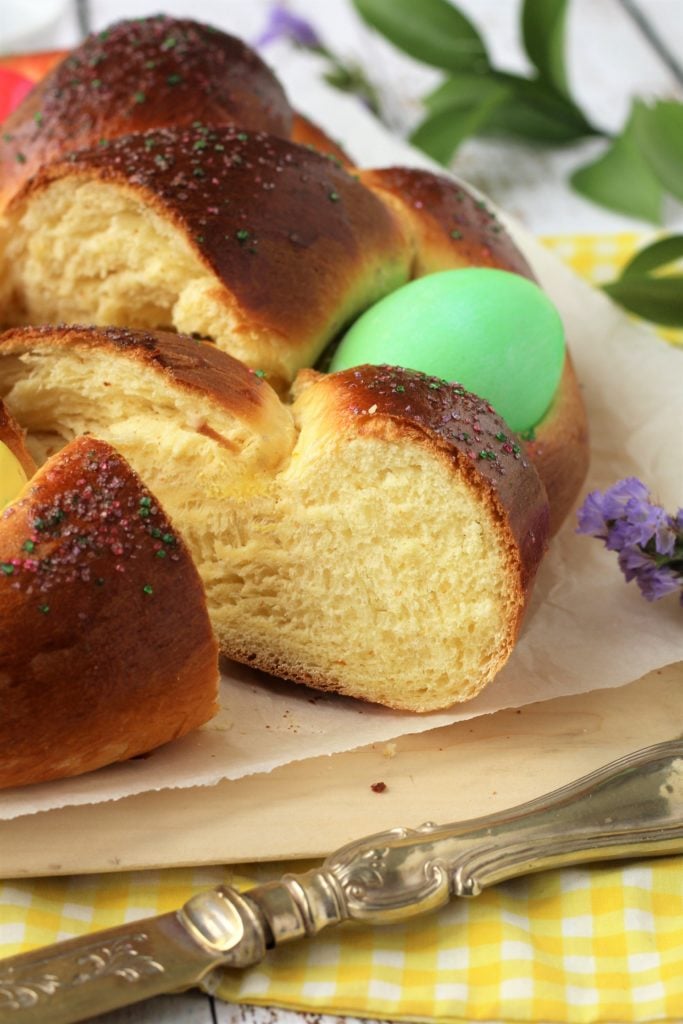
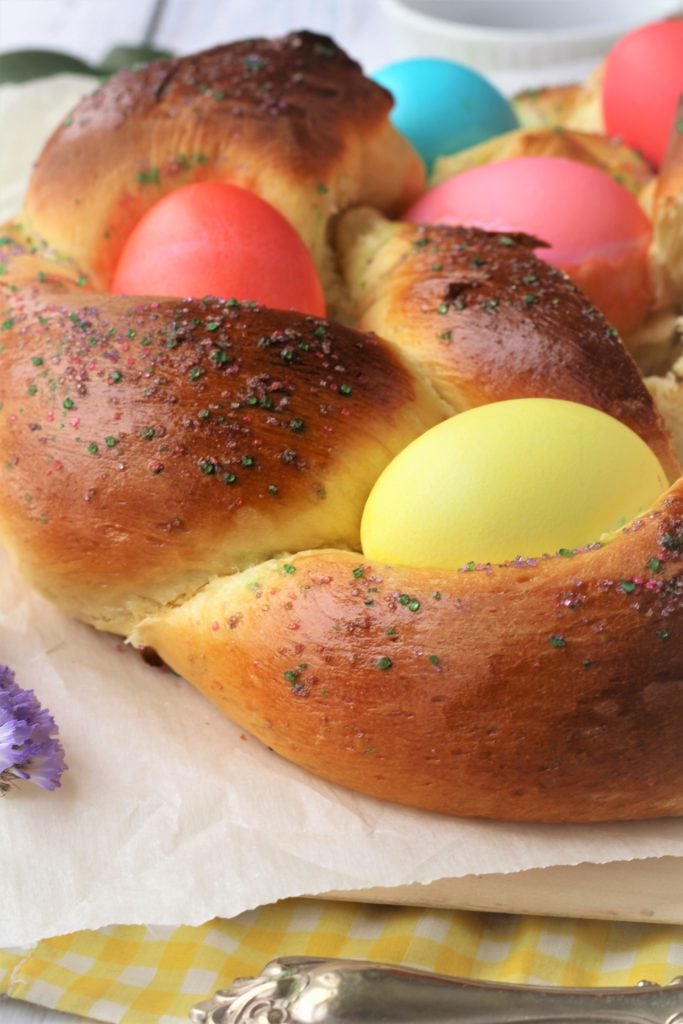
Did you try out this recipe?
Let me know how much you enjoyed it by rating it in the recipe card below!
*****
More Easter recipes for you to check out!
- Mom's Sicilian Ricotta Pie
- Sicilian Easter Bread (cuddura cu l'ova)
- Sicilian Easter Cookies with Eggs
- Sweet Ricotta Easter Calzone
- Easy No Crust Easter Pastiera
- Almond Paste Cookies with Icing (paste reali)
- Pizza Rustica (Italian Easter Pie)
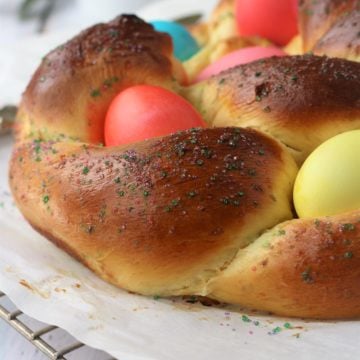
Italian Braided Easter Bread with Eggs
Ingredients
For the brioche dough
- ¾ cup milk plus 1 tablespoon for the egg wash
- 8 grams active dry yeast (1 package)
- 4 large eggs 1 egg reserved for the egg wash
- ½ cup granulated white sugar
- 3 teaspoon honey
- 1 teaspoon vanilla extract
- 1 orange, zest of
- ⅓ cup butter cut into cubes and at room temperature
- 4 cups all-purpose flour
- 1 teaspoon salt
For decorating
- 5-6 large eggs as is or dyed
- colored candy sprinkles optional
Instructions
For the brioche dough
- Proof the yeast: place a packet of active dry yeast and 1 teaspoon sugar (taken from the total amount of sugar) in a bowl. Warm milk until lukewarm and pour over the yeast. Let sit for 10 minutes until foamy
- Meanwhile, in the bowl of your stand mixer fitted with the paddle attachment, mix eggs and sugar until smooth.
- Add honey, vanilla extract and freshly grated zest of 1 orange. Mix well and pour in the yeast mixture.
- Add cubed softened butter. Mix all ingredients. Note that the butter will not dissolve into the mixture at this point. This is normal.
- Remove the paddle attachment and replace with a dough hook. With the mixer running on low speed, begin adding flour ½ cup at a time as well as the salt.
- When all the flour has been added, increase to the next speed and knead the dough for 10 minutes. It will be slightly sticky and will wrap itself around the hook.
- Transfer the dough into a lightly greased bowl, or you may leave it in the food processor bowl to rise. Cover and let rise in warm place for 3 hours until doubled in bulk. I place my dough in my unlit oven with the light on.
To shape the Easter bread
- After the initial 3 hour rise, use a kitchen scale to divide the dough into 3 equal pieces. Roll out each piece of dough into an approximate 24-inch long rope.
- Place the palms of your hands in the center of the rope and roll gently pushing outwards to stretch out the dough.
- Do not add any additional flour to your surface when rolling the dough. If the dough slides underneath your hands, wet them with just a few drops of water.
- Pinch the ends of the 3 ropes together. Braid the ropes and pinch the other end together. Connect both ends to form a circle, or if you prefer, leave as is.
- Nestle the eggs in the bread. Let rise for 2 hours in a warm place.
- Preheat oven to 350 degrees F. Brush the bread with an egg beaten with a spoonful of milk. Sprinkle with colored sprinkles (optional),
- Bake for 15 minutes, then cover loosely with foil and continue baking until browned both on top and underneath the bread.
- You will notice that the bread will brown quite a bit after the first 15 minutes of baking, but the interior will still be raw. Covering it will ensure that the interior bakes sufficiently without burning the exterior.
- Transfer to a wire rack to cool for a few minutes before serving.
Notes
-Replace the vanilla extract with anice extract.
-Add a handful or raisins or chocolate chips to the dough. Can brioche dough be prepared the night before? -The dough may be prepared the night before and be refrigerated until the following day.
-Let the dough come to room temperature before shaping it. Can I make smaller individual Easter breads instead of 1 large wreath? -For small individual breads, divide the dough into 6 pieces. Roll each piece into a 12-inch rope. Join both ends and twirl the rope (instead of braiding it).
-Place an egg in the center of each wreath.
-They will bake in less time (18-20 minutes), however the eggs will be soft cooked instead of hard. If not eaten the same day, remove the eggs from the bread and keep refrigerated. Can Easter bread be made without the eggs? -You can bake the Easter bread without the eggs.
-This may be your best choice if you wish to freeze the breads or in the event that you are baking them in advance as the eggs require refrigeration if they are not eaten the same day the bread is baked. How long does this bread keep for? -The texture of any brioche bread is best the day it is baked as it tends to dry as the days go by.
-However, leftovers may be kept at room temperature well wrapped for up to 5 days. Can Easter bread be frozen? -Yes but without the eggs still nestled in the bread. Wrap tightly and freeze for up to 1 month. How is Italian Easter bread served? -The sweet brioche bread is delicous eaten as is or for breakfast the next day, toasted and spread with jam or butter.
-Enjoy the baked eggs with a light drizzle of olive oil and a sprinkle of salt on bread or toast for breakfast, lunch or as a snack. -Please note that the nutrional information provided is approximate and may vary according to exact ingredients used and portion size.


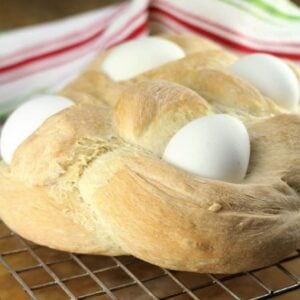
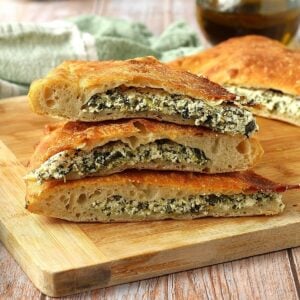

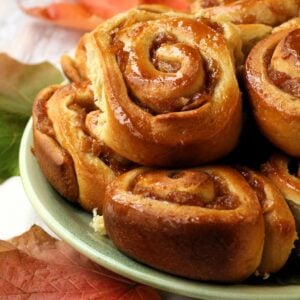
Anna Bucciarelli
Nadia, you wake up such wonderful memories for me ... never an Easter that mama didn't make this bread, along with small individual ones for the little kids in the family, her version of an Easter basket for them. When I had little ones I did the same but as an old woman with no rugrats around, I had all but forgotten about this. Along with Pizza di Grana and rice pie, I will definitely work these next weeks before Easter to make at least one big loaf of this. Hopefully Cophid will continue to decline somewhat but who knows with Omecron appearing again in big numbers in China and Europe. Anyway, do have a joyous Easter, and many thanks for keeping old recipes alive and teaching us newer ones. You are a treasure!
Nadia
I understand Anna! My mother's braided Easter bread brings me back as well. Actually she still makes a large one for me and smaller individual ones for mu children just like you mentioned. And I love all of them: the cookies, the savory breadd or this brioche! I do hope you are able to enjoy Easter with your family this year. Wishing you, always, lots of good health and thank you once again for sharing your memories with me!